Today’s post is mainly going to be about a topic I have had questions about many times, how to tackle Red Lily Beetles. I absolutely adore lilies and can’t get enough of them, and when I moved house earlier this year I lifted as many bulbs I could find and ended up with 164 lilies in pots – the rest I left to the new tenant, probably nearly 100 of various size. Over the years I have tackled a lot of pest and diseases in my garden, some more frustrating than other, but lily beetles are not really a big problem to me despite the fact that I live in London where the problem with lily beetles is very common.
It is part of my garden routine to patrol up and down the lily beds and pots with my reading glasses on, inspect them each carefully, and catch and dispatch any lily beetles found. Now this is where there is a little bit of skill needed. If you come between the adult beetle and the sun, the sudden darkness is a sensory trigger and they will flip off the leaf onto the soil, with their bright red backs to the soil, lying still for 20-30 seconds, playing dead, so they are no longer visible. Also, if you knock the plant, the movement is a trigger for them to flip off the plant onto the soil - again playing dead. I use a white plastic lid which I carefully hold under the plant if I find a lily beetle and then I bend the lily slightly so the beetle can drop straight down onto the white lid. As the beetle is programmed to do, it will land on its back with the feet in the air, being still for a long time – which gives me time to slide it off the lid down on the ground and stamp on it until it is dead. Yeah! Oh....and they make a squeaking noise when under attack! Squeak all you like matey – you are not an invited guest!
All the work picking off the beetles is worth it, as keeping the numbers down means less beetles that can mate and lay eggs. The adult beetle overwinters in the soil or plant debris and emerges in early spring looking for food and a mate. After mating, the female lays eggs in lines on the underside of lily leaves, and the grubs cover themselves with black excrement to disguise themselves as bird droppings! Some damage is done by the adults at this time, but the major damage comes when the eggs hatch into larvae in 7-10 days. The larvae ravenously consume all leaves within reach and then start on the flower buds. This continues for 2 to 3 weeks, when the larvae then drop into the soil and begin to pupate. In another 2 to 3 weeks the adult beetles emerge to start eating again. This process occurs from early spring to late summer. Lily beetles are particularly troublesome because they strip lilies of their flowers and leaves, weakening the structure of the plant and often killing it. They can even affect next year’s bloom, as an attack on the flowers early in the season can affect the bulbs, meaning you could only get leaves with no flowers next year or the bulb can even die.
If you search for treatment for Red Lily Beetles you will probably find either that there is none – or that you can use Provado Bug Killer or something similar. But there is a nature friendly product that works very well against lily beetles and I am amazed it isn’t more known and advertised. I use the organic systemic pesticide from a company called Pireco, it is made of fermented soy and herb extracts. It can be used as a soil application and a foliar spray. I use it on the soil every 4 weeks from March-September and as a top up as a foliage spray when necessary, especially in the spring when foliage is new, root uptake slow and pests like aphids at their worst. It works on all sucking insects including greenfly, scale insects, carrot fly, whitefly, scarlet lily beetles, gall midges, spider mite and thrips, but useful insects like bees and butterflies are not affected. Over time, the amount of lily beetles will go down and picking the few that appears from other gardens before they produces grubs will prevent new ones appearing next year.
I could not do without this pesticide and keep a stock of it as it is also very good against aphids and spider mites. I buy it from a company called Bakker here in UK, they only deliver to UK, not sure if it is available in US – but Bakker is available in 21 European countries and here is a link where you can find Bakker in your own country.
Here is a link to the Pireco producer in Netherland (can’t find an English version of their site so I used Google translate – a bit silly translation here and there....) They produce a range of products, I only use the ‘Foliar for insects’ liquid, the capsules are for people with much less plants than me, it would take ages using capsules and be very costly, but fine if you only want to treat a few pots, the liquid is quite economical in use and much quicker to apply.
Here is an Irish company selling Pierco products, they don’t sell the same ‘Foliar for insects’ liquid, instead they have two different liquids from Pireco, one for herbaceous plants ‘Herfosec’ and one for woody plants, ‘Folisec’ – they are products more for nurseries and the industry I think, worth looking into if you can’t get hold of the one I use as they do international deliveries. I have been meaning to order from them to try out their ‘Herfosec’ as it would be more economical in the long run for me so if I can get around to do that for next spring I will write an update on whether there is a difference.
You can read about how to use those two products on Pireco’s website, translated by Google:
My experience with using Pireco ‘Foliar for insects’ is that over the years the number of lily beetles have gone dramatically down – to almost none. I think the ones I find these days are mostly coming from other gardens and not from mine and as long as I can manage to catch and kill the few I find in time before they lay eggs they do little harm. It is the grubs that really give trouble in the garden, they can ruin a whole lily crop in just 3 weeks if left to it and I haven’t seen any grubs in years. Soil pouring and spraying really helps, the plants take up the liquid by their roots and leaves and the smell deters the beetles, the effect last up to 4 weeks if applied correctly. I treat all the plants in my garden usually affected by aphids, lily beetles and spider mites, probably more than half of the plants I have and with a monthly or so application from March-September my roses are usually free of aphids too, although early in the spring when the leaves emerge the roses need a bit foliar spray with this liquid too as a top-up.
One note of caution though, the liquid smells disgusting!! And because it is an oil-based liquid it will linger in your house for days if you mix it indoors – I am speaking of experience, so mix it with water outdoors just before you apply it and don’t store any leftovers, just mix what you need.
I have to add here that I am in no way connected to Pireco or Bakker and I have not been paid or given products to write this post and I have not been asked by any of the companies to write about their products. I don’t normally endorse products on my blog, but sometimes I like to share my experience about products I find useful and hope that other people will benefit the same way I have. If however Pireco or Bakker should happen to read this post I would have no objections to be sent for example a year’s supply of ‘Foliar for insects’ – that would be a very welcome surprise....hint, hint :-)
It would be nice to hear from readers who have experience with ‘Foliar for insects’ on lily beetles, or perhaps you use it mainly for aphids, would love to hear about that too. If you have any other tips than just picking and discarding lily beetles, please leave a comment too!
OK, enough about those terrible little blighters! Ugh!....they give me the creeps, let’s move on to something nicer, it is Garden Bloggers’ Bloom Day today and I do have some flowers to show you, but I will try to make it slightly shorter than I usually do since this post is already quite long.
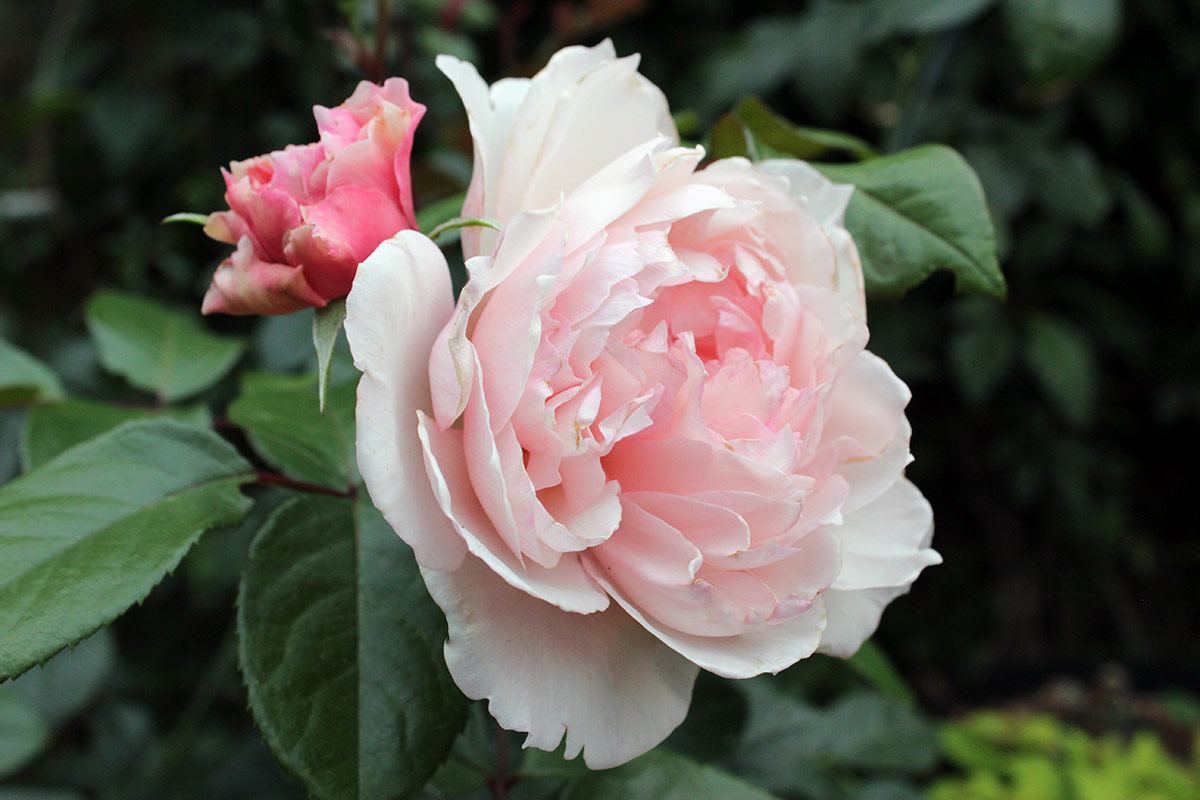 |
My roses are continuing to flower, I am sure they would all like me to hurry up and finish the main part of the garden so they can get their feet out of the containers and into the ground – but it’s slow work and will take many more months. This is 'The Generous Gardener'.
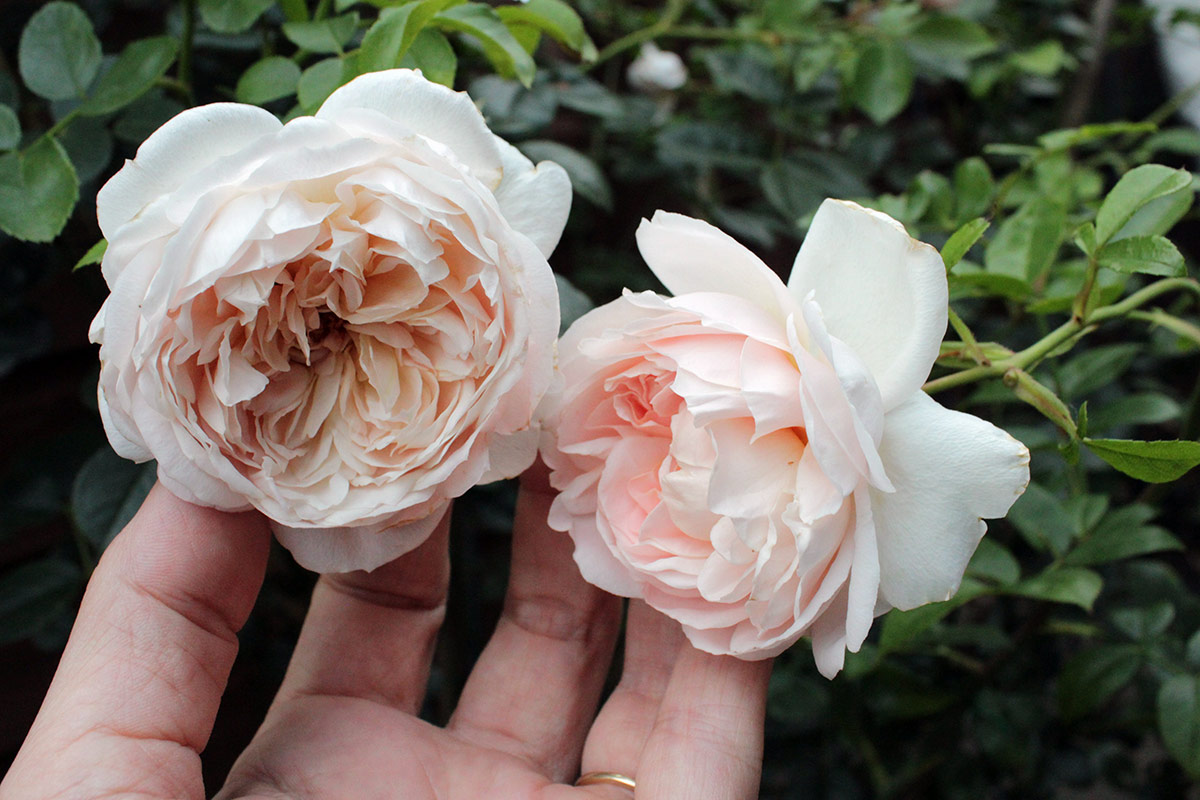 |
This is 'Wildeve', surprisingly well flourishing in the small container, now in its 3rd year.
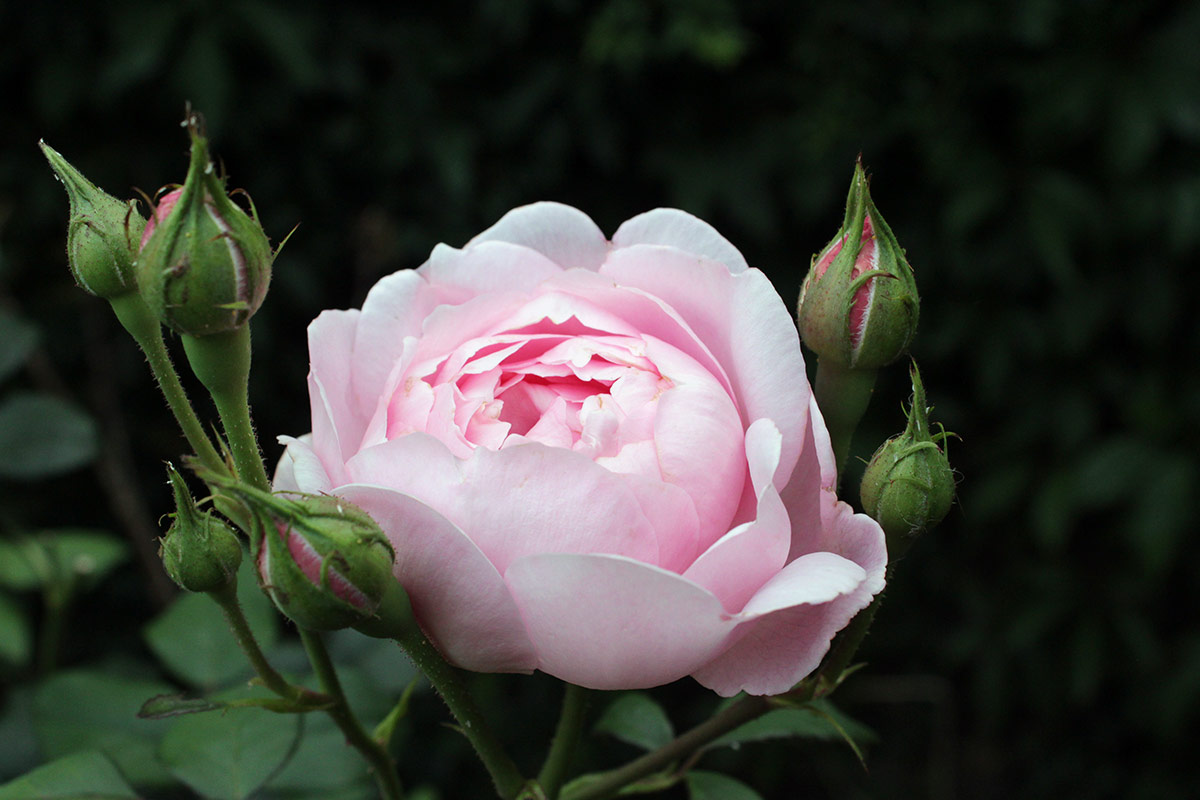 |
And this is 'Scepter'd Isle', also 3 years old, not yet reached its peak I think, but hopefully when out of the container it will be happier.
 |
‘Rob Roy’ is many years old, but has lived all his life in the same container and would probably be a much better rose in the ground – but I still get lots of roses from this amazing bush every year despite container life. The colour is bright red, a colour very difficult for my camera to capture.
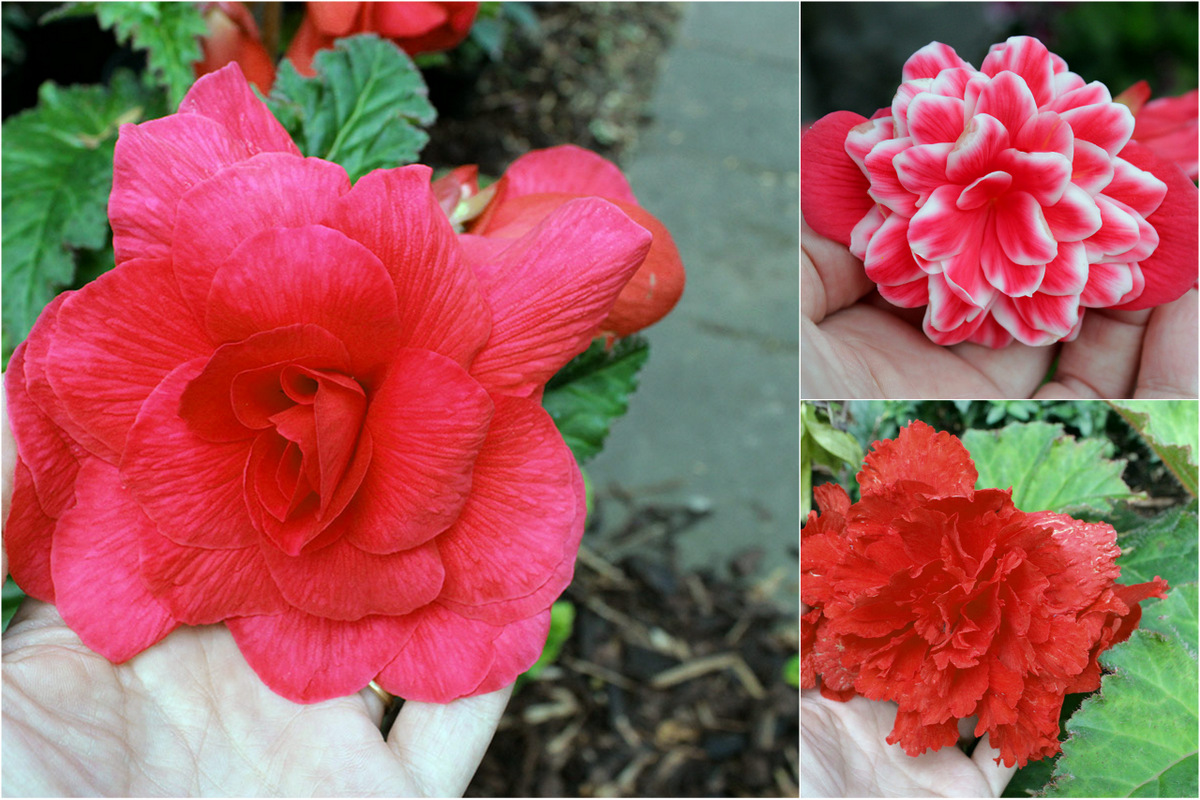 |
Speaking of red, here are my incredible begonias, they have absolutely HUGE flowers! This is what you get when nurseries breed for show and not for practicalities. Every stalk needs to be staked or they just bend down to the ground, and even then, the flowers tend to face downwards when fully opened because of the weight of them. Amazingly, I just cut these begonias down last December, stuck the pots under my garden bench and left them there over the winter – and they came back this spring looking just as nice as last year. Who needs a greenhouse?! Just kidding, I would REALLY like a greenhouse!
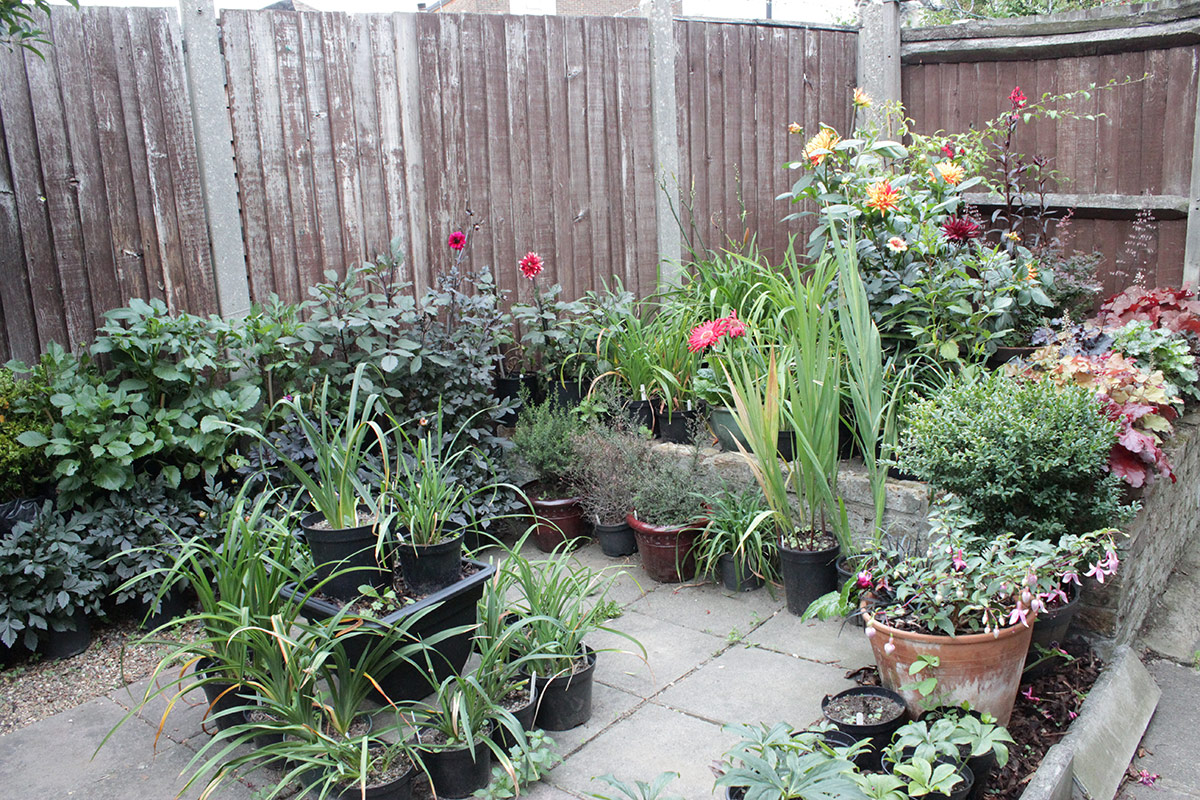 |
And this is the space where my greenhouse is planned for, hopefully next spring. At the moment it is a bit sparse in the flower department as most of the daylilies are finished and many of the dahlias here haven’t really taken fully off yet.
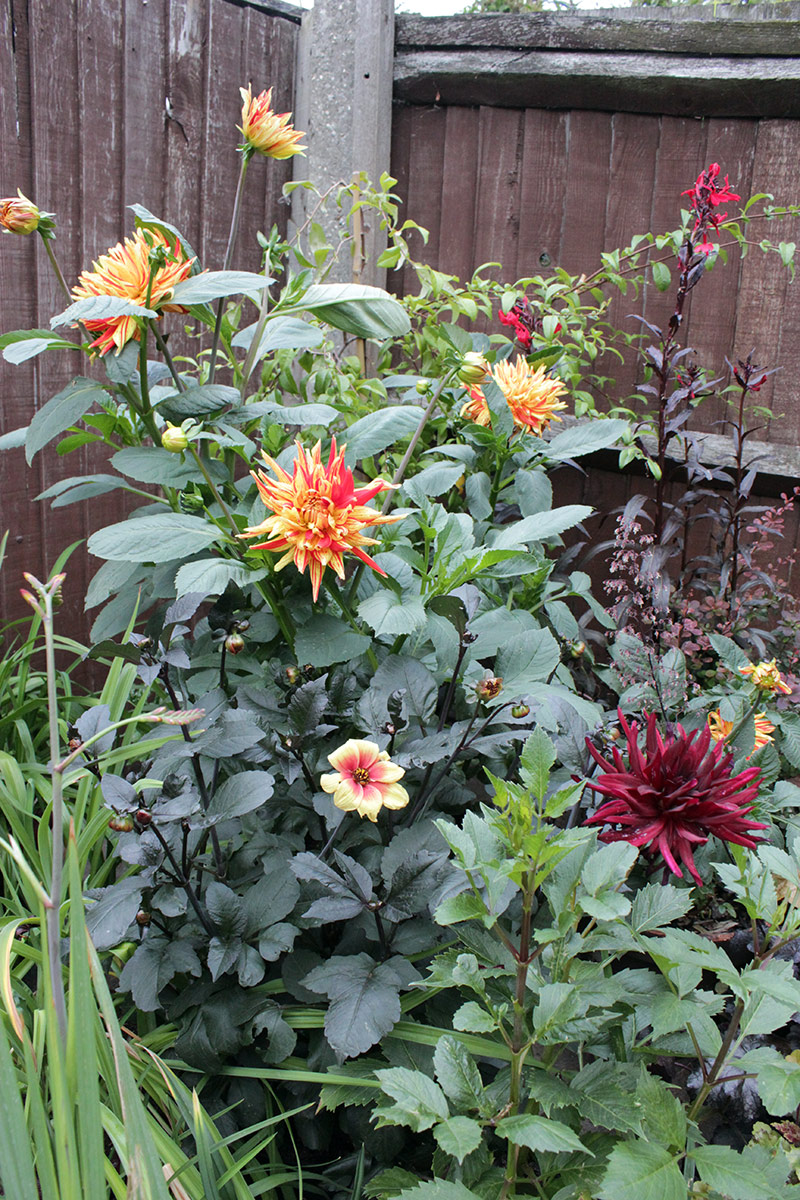 |
But some of the dahlias have been flowering for a while, here are some well-known from my previous garden: 'Striped Vulcan', 'Sunshine', and ‘Nuit D'Ete’ – and you can also see Lobelia cardinalis 'Queen Victoria' in the background with its red flowers.
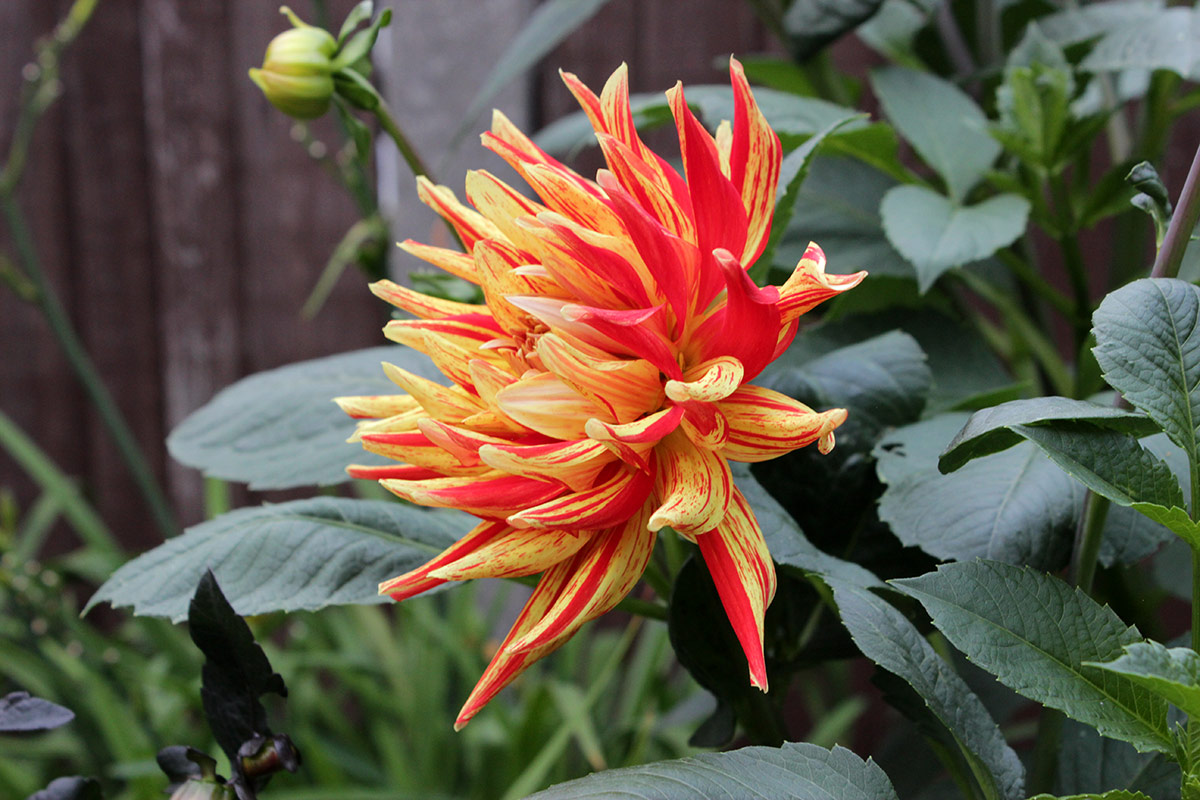 |
I dug up 'Striped Vulcan' from my previous garden and I should probably have taken a picture of the tubers as they were absolutely humongous! No wonder then the dahlia get so big and tall. Perhaps you remember from previous year I always wondered about its name, being plain orange, and then last year it produced striped flowers for the first time! I am happy to report 'Striped Vulcan' has found its stripes this year too, despite being pulled up, squeezed into a pot and transported into a new garden. This was a free-bee I got many years ago, I don’t think I would have bought it myself. I will try to find a place for it among the hot coloured dahlias and daylilies – it definitely doesn’t go well with pinks....
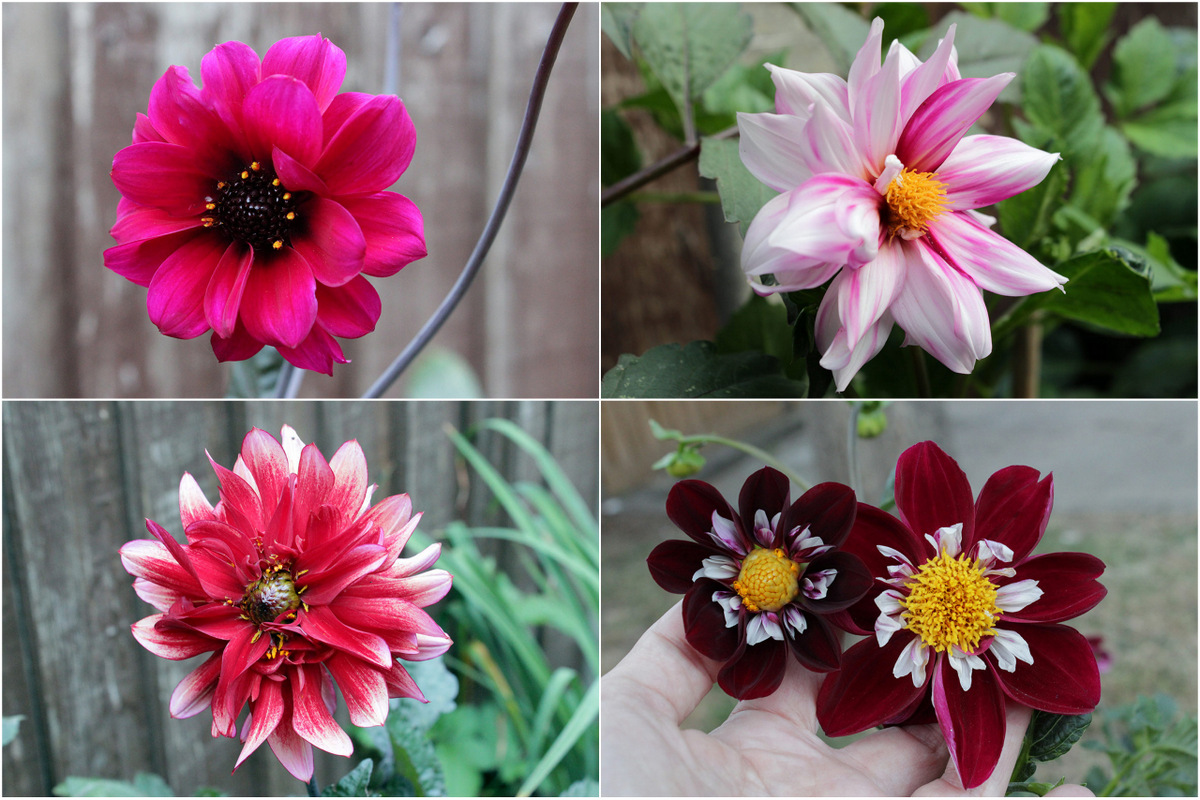 |
....which is what I got most of. I got a couple of the bishops last autumn, ‘Bishop of Canterbury’ is the first one to flower, top left - the other bishops will have to wait for a later post. 'Edge of Joy' is top right, 'Darkarin' bottom left and bottom right is 'Mary Eveline' which I have 3 of and have had for many years.
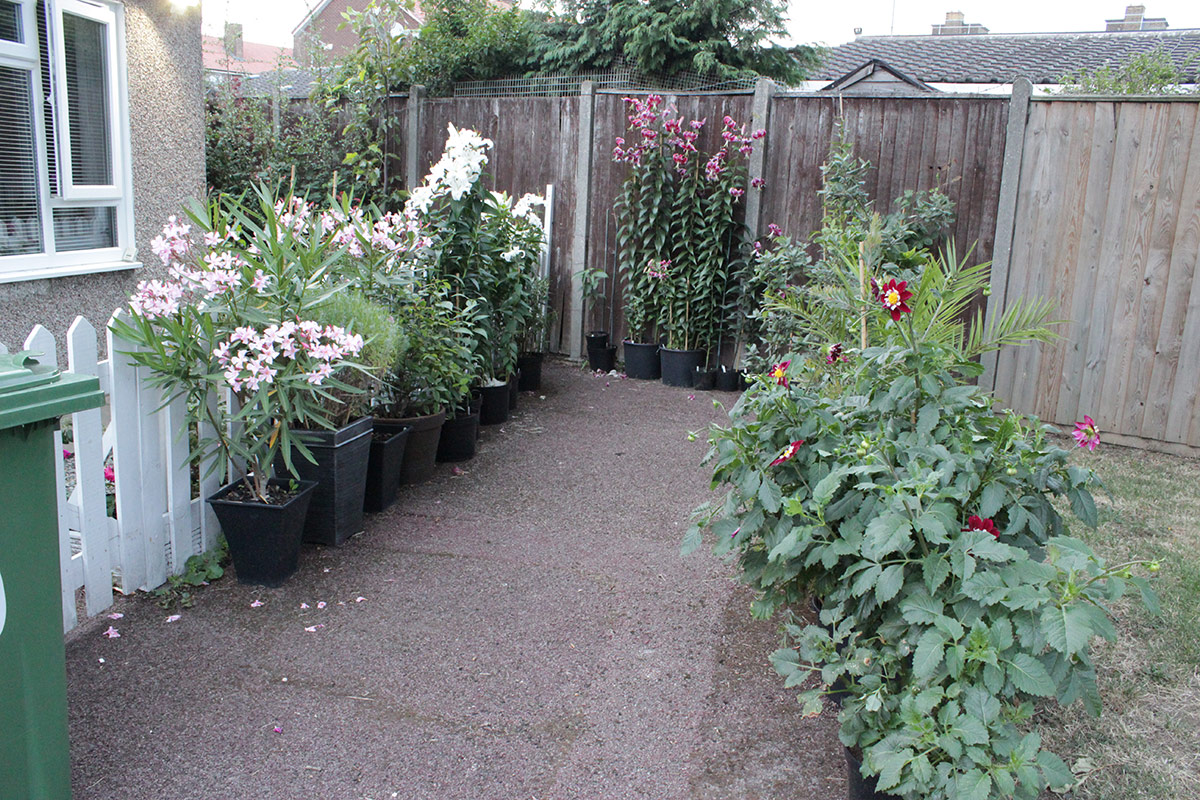 |
Out in the front garden, or front of front garden to be correct, the lilies are almost finished, only 'Miss Feya' along the fence is still going strong and the late 'Casa Blanca' lilies are still wafting perfume to anyone passing by, including everyone delivering parcels and groceries to me. I have had so many comments about my lilies that I have decided to have some permanent here in my front garden and not move all of them to the flowerbeds in the back garden as I planned.
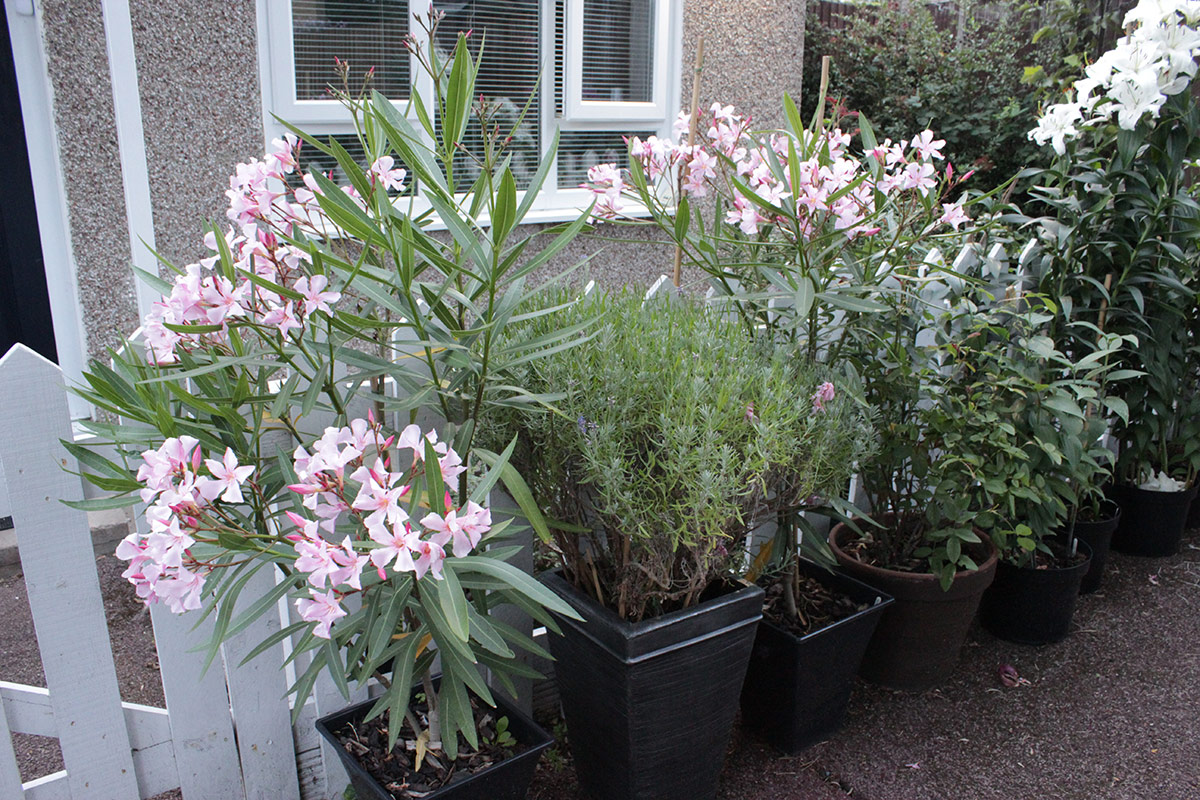 |
Out here I also have my two oleanders, which I bought because I love scented plants. They were advertised as sweetly scented and when I Google oleanders I find things like ‘Oleander flowers are showy and highly fragrant and are grown for ornamental purposes.’ But my oleanders don’t smell a thing. Nada! I don’t stick my nose completely into the flowers, as I know they are poisonous, perhaps not as much as the leaves are, but still – but when I lean close over them I should be able to detect a scent if they were ‘highly scented’, shouldn’t I?
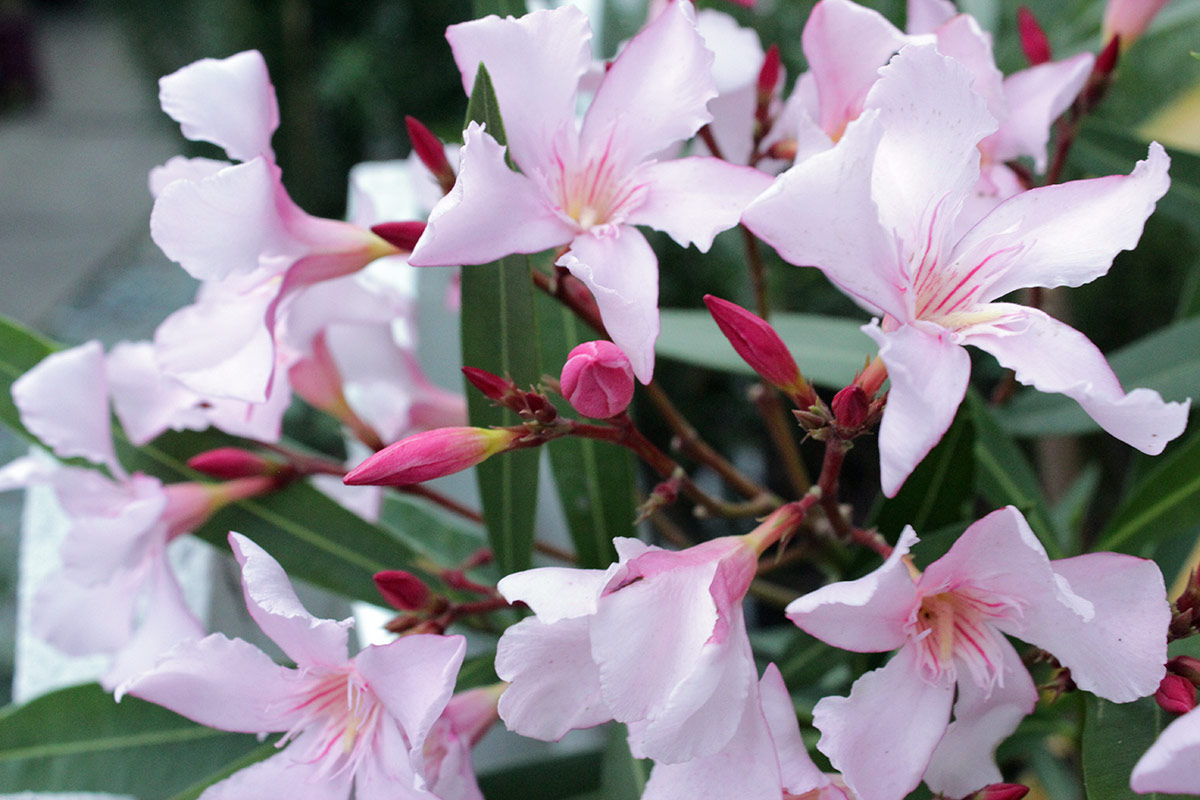 |
Well, if anyone knows of a trick to get them to start smelling nicely, please let me know, as this is second year they are flowering and I am kind of fed up waiting for the sweet scent. The flowers are nice enough, but that’s not really why I bought them....
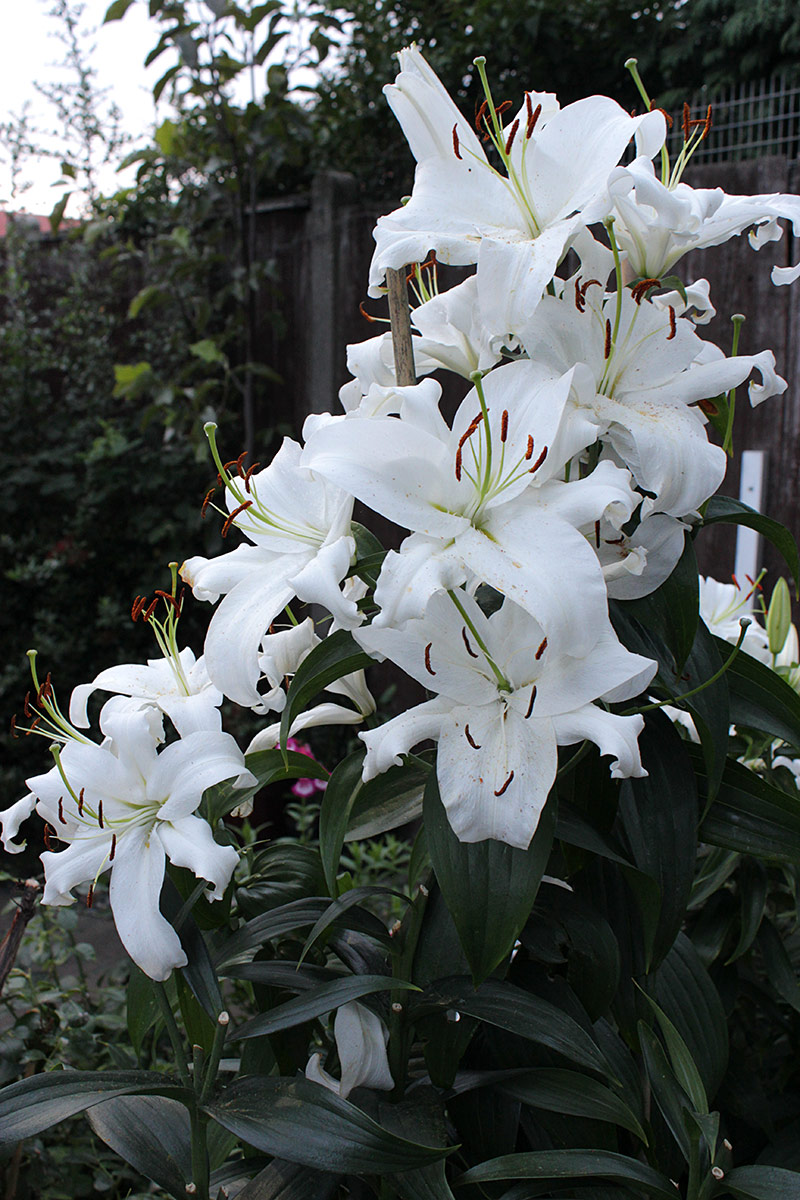 |
At the other end of the front garden, the ‘Casa Blanca’ lilies in containers are pumping out perfume making up for the lack of scent everywhere else. These lilies are a good few years old and the bulbs were enormously big when I lifted them in February, I dread digging a hole for them when that time come as they need a good, deep hole.
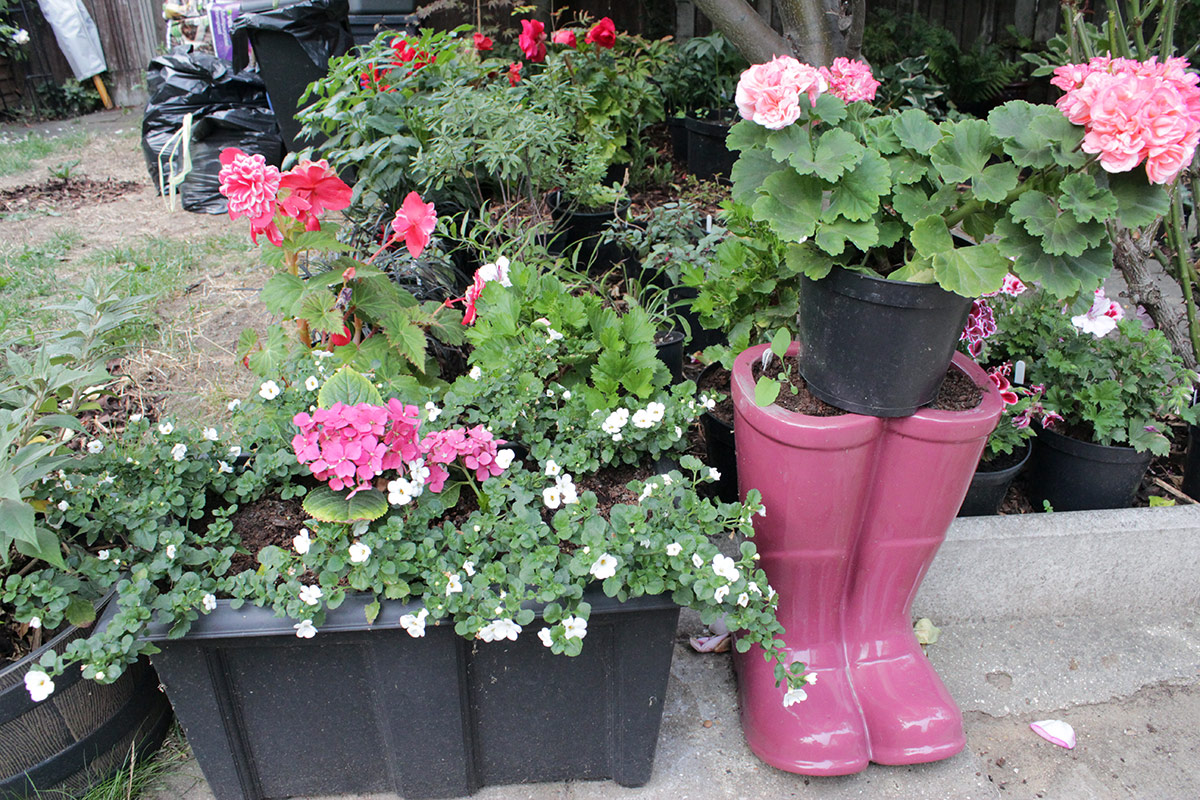 |
Back in the main garden I have found time to plant some of the cuttings and plug plants that desperately needed bigger pots. The white ones are Bacopa Abunda ‘Colossal White’, they could have been filling this container by now but almost perished on a shelf while waiting to be potted up.
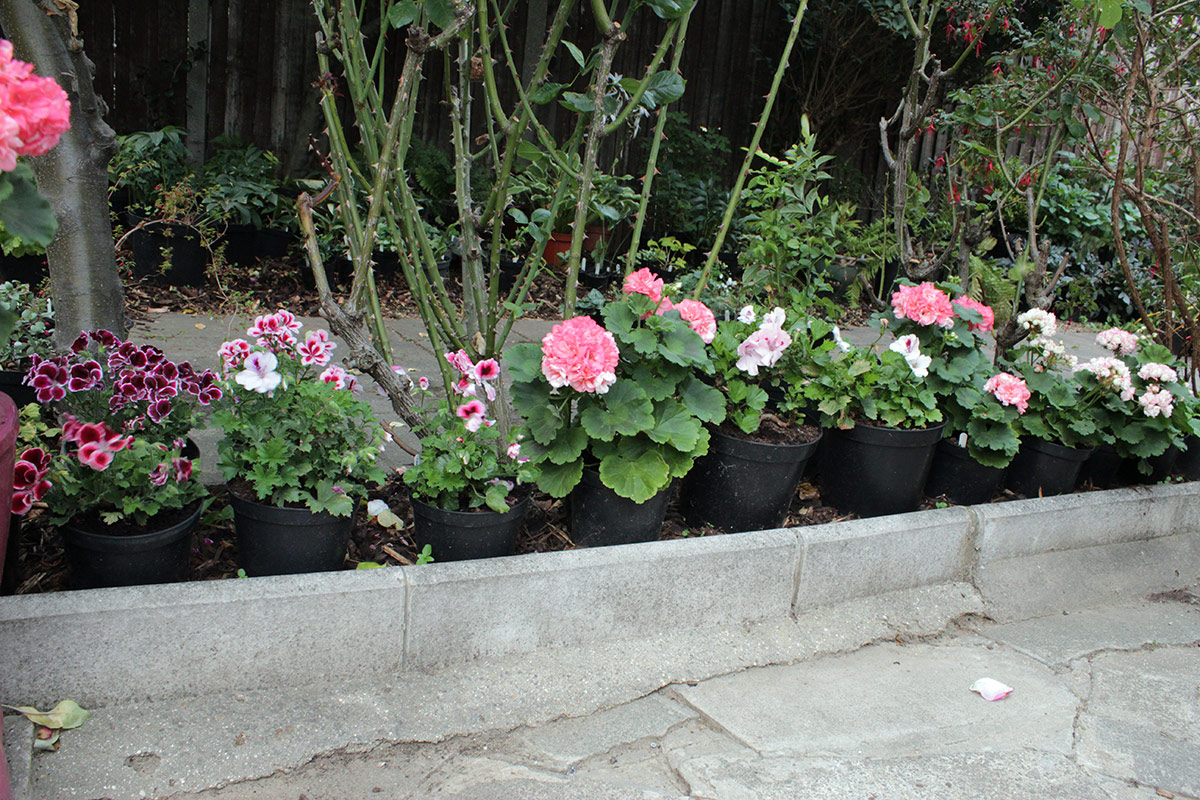 |
The pelargoniums have all got a proper pot and have rewarded me with lots of nice flowers.
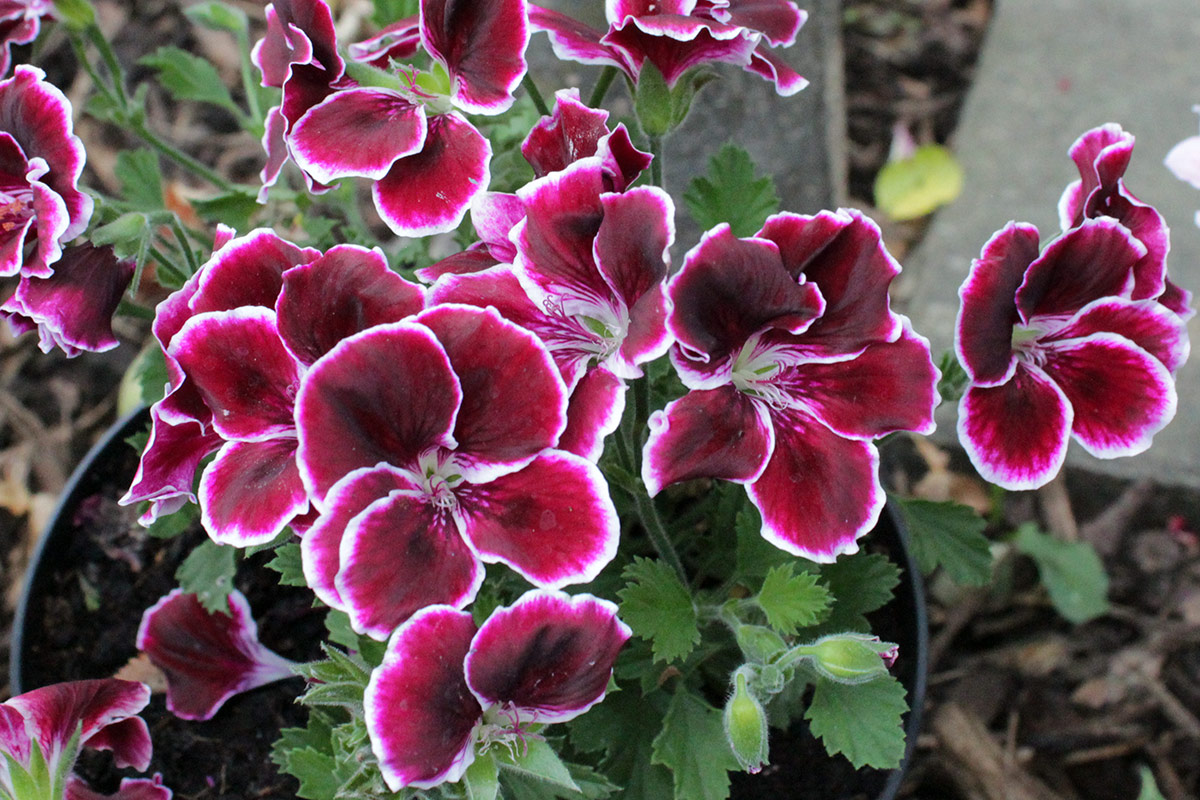 |
I especially like this little angel, Pelargonium grandiflorum Aristo 'Black Beauty'.
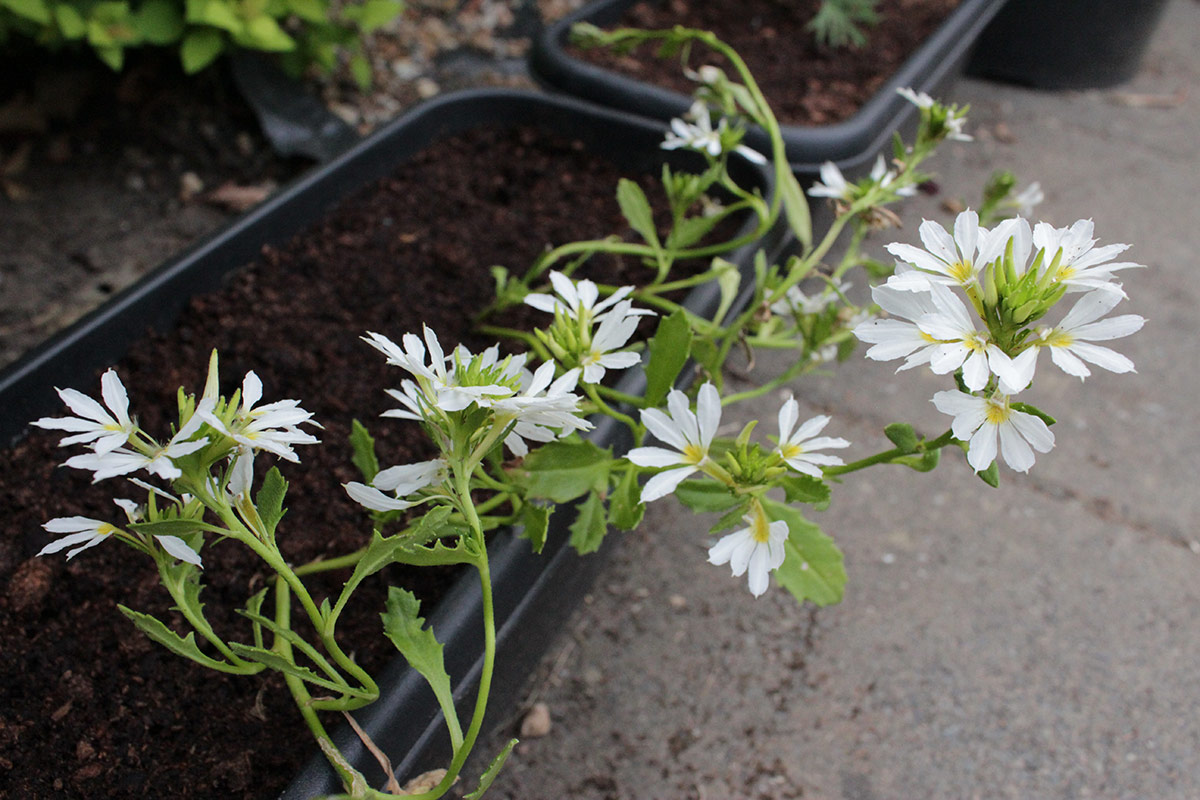 |
Final new potted up is this Scaevola aemula 'White Wonder' – usually treated as an annual here in UK, but I will try to keep it over winter. Time will tell if I succeed with that :-)
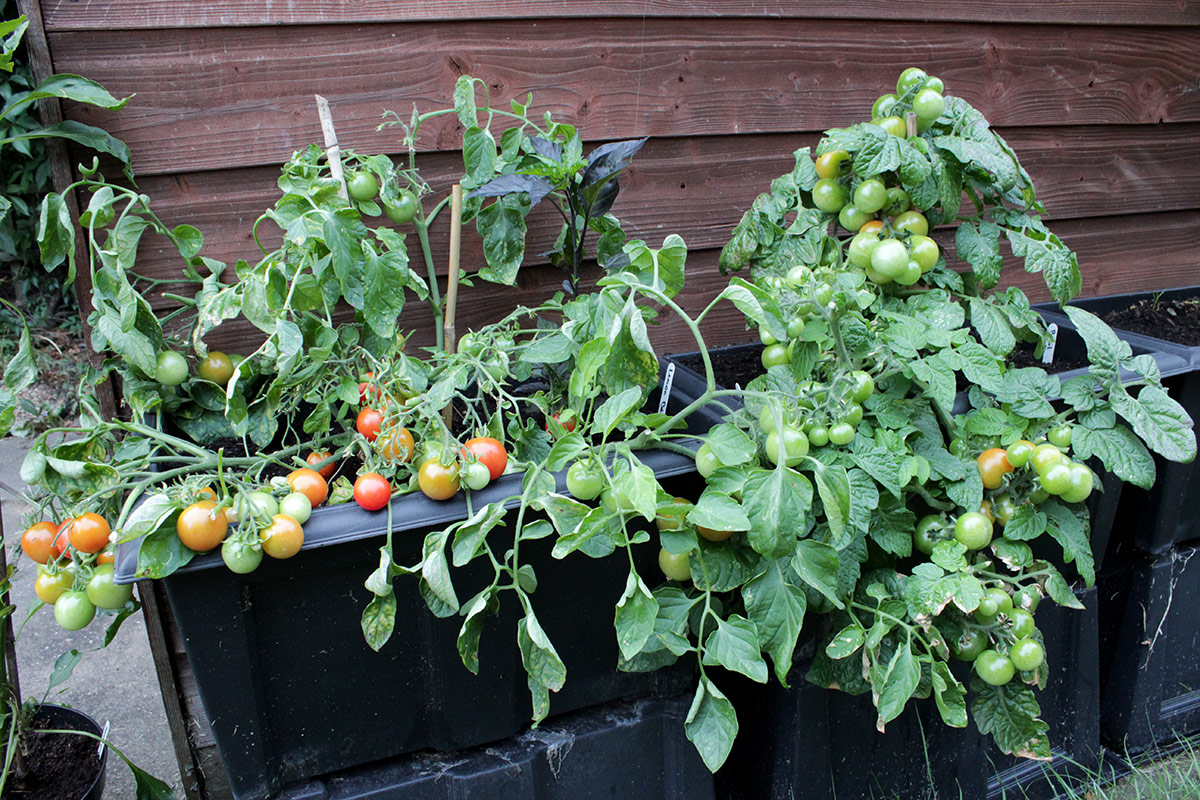 |
Over in the temporary vegetable garden, the cherry tomatoes ‘Tumbler’ has been giving me lots of tomatoes for many weeks already and is in the final stage. The next tomato plant has the imaginative name of 'Window Box Red' and is a later variety, just starting to ripen – perfect timing – I will have tomatoes for another two months I think.
 |
And I have peppers for the first time in many years, these are called ‘Marconi’ and will be even bigger and longer before it’s time to harvest them.
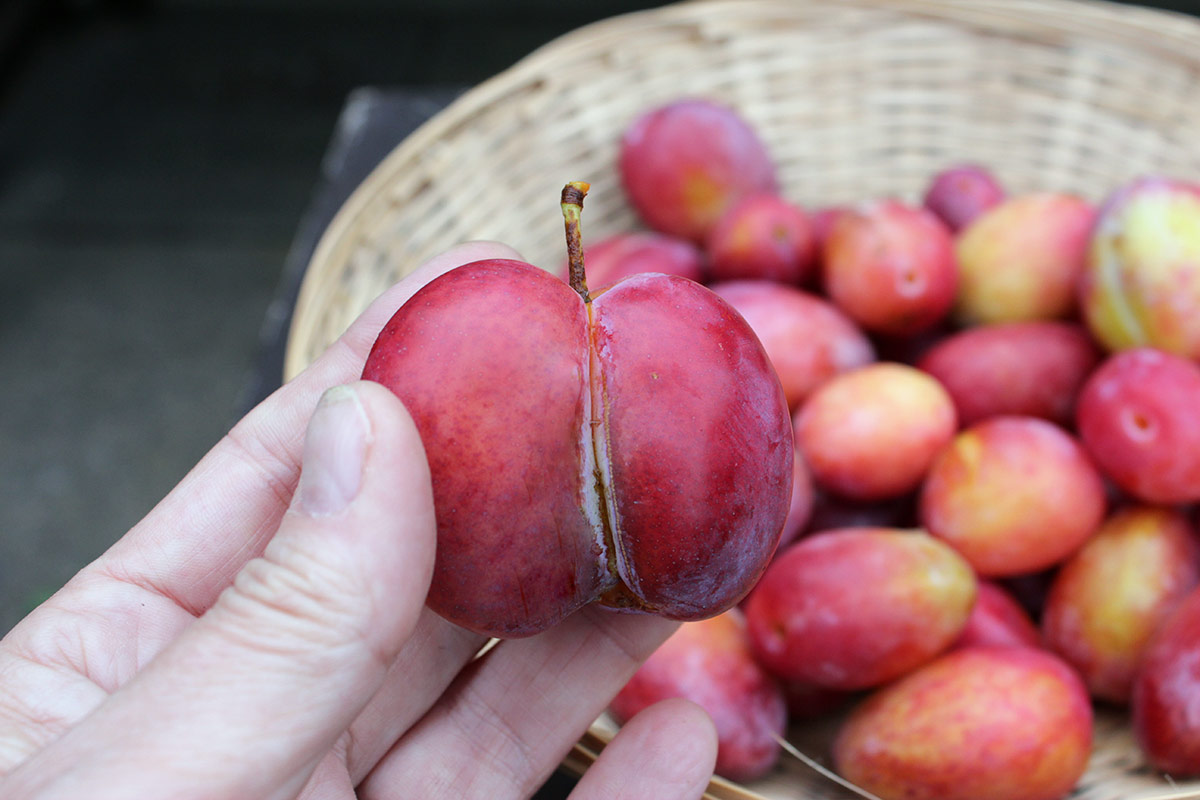 |
The plums are all gone, the last ones went in the freezer yesterday as a trial, not sure how nice they will be after being frozen but I will take them out and make something of them for Christmas and if that’s a success I will do that with more next year instead of giving them away. I used to do a lot of preserving and jam making but I am no longer able to do such things, packing things in plastic bags and put it in the freezer was easy enough. This sweet Siamese twin plum ended up in my mouth though :-)
 |
And finally, a before and after picture for you. This was a corner of my garden on GBBD in June.
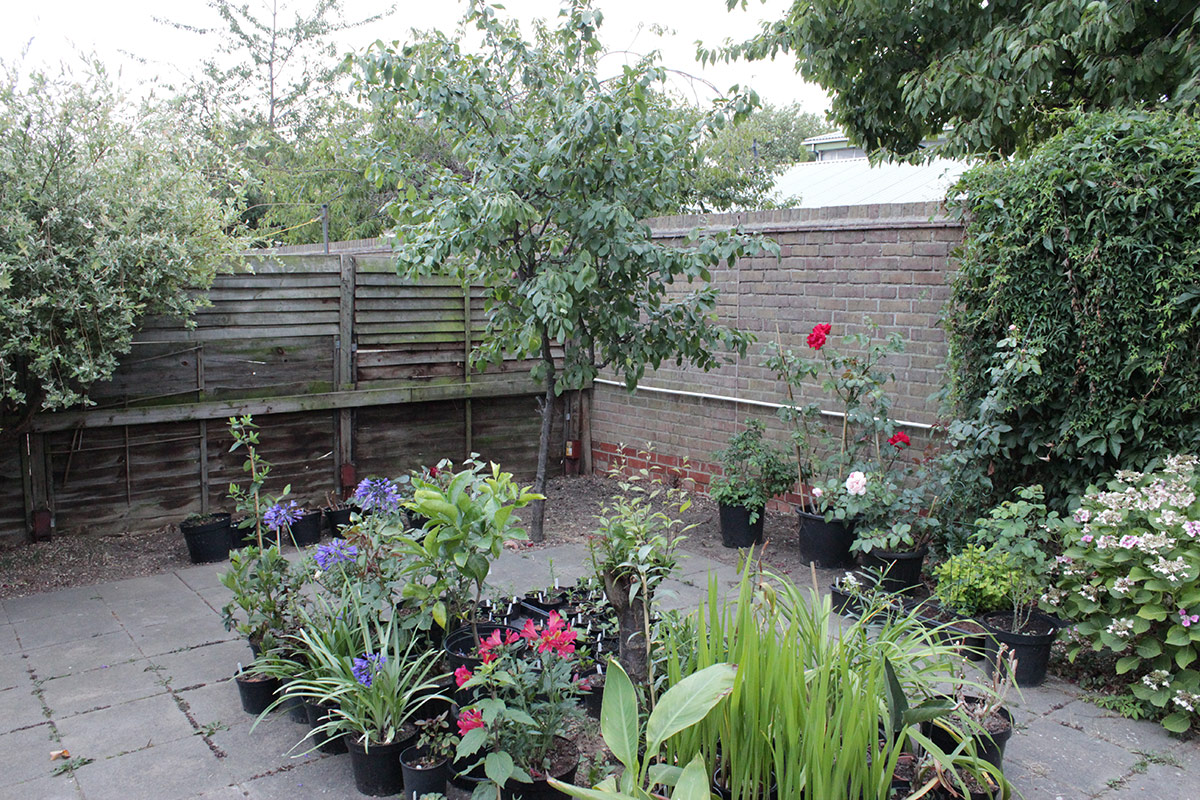 |
And here is the same corner today! I have started to take down the Parthenocissus, and uncovered a lovely brick wall at the bottom of my garden – plus a rather ugly fence to the left of my garden. The fence needs replacing, so that’s another post on a very long list of expenses, but the wall is a rather nice feature I think I am going to appreciate. I like the wall so much that I am now wondering if I should perhaps remove the whole Parthenocissus instead of leaving half of it which was the plan. Up that wall I can grow roses, honeysuckle, clematis, kiwis and apricots and….well, the list is endless. But as long as the Parthenocissus is covering the wall I can’t really grow anything else there, and although it is amazing for a few weeks in the autumn when it is flaming red and orange, Parthenocissus isn’t much of a feature the rest of the year. I’ll let you know when I have made up my mind about the rest!
I better round up this post before it gets way too long, even though I have many more plants in flower, but you can see some of them on my next post at the end of the month, or you can send me a friend request on facebook.com/helene.u.taylor as I regularly post short messages and photos there between posting here.
Until next time, take care.
I am linking this post to Carol at May Dreams Gardens.

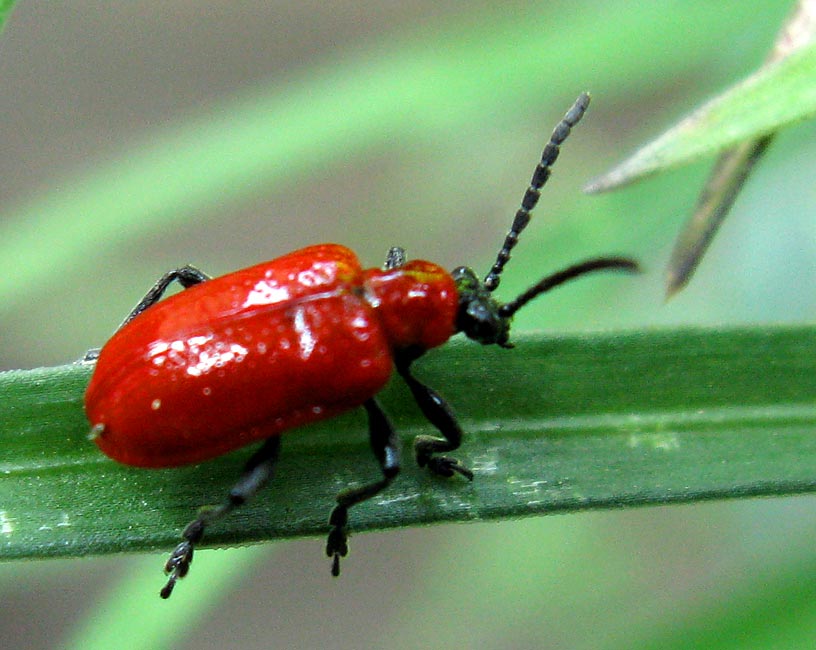
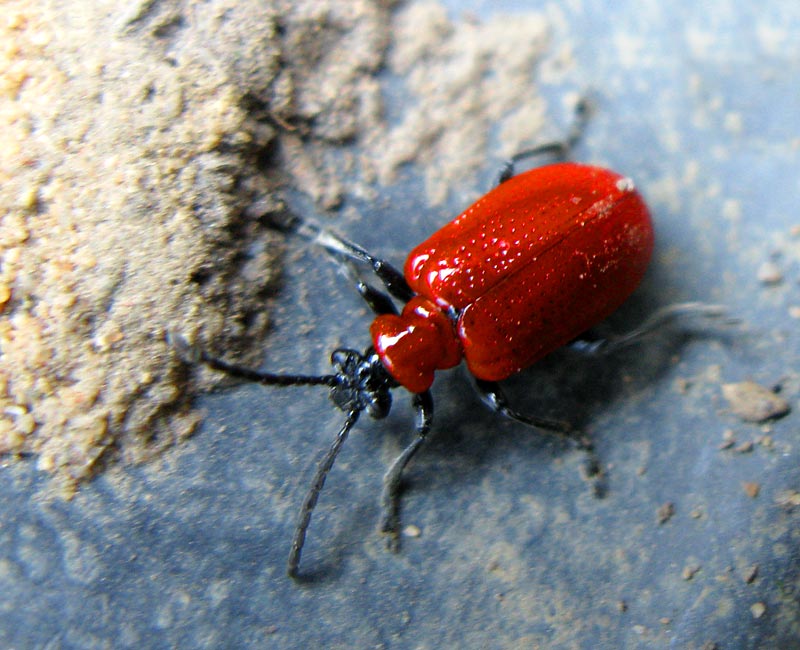
Intressant läsning om liljebaggar. Du har vackra Dahlior och Liljor i din trädgård.
ReplyDeleteHa det så bra! Marika
Hei Marika, morsomt å høre hva red lily beetles heter på svensk, har ikke hørt ordet liljebaggar før :-)
DeleteSom du kanskje vet så kan man handle fra Bakker både i Norge, Sverige og Danmark, men av en eller annen grunn så selger de ikke ‘Foliar for insects’ i Norge, bare i Sverige og Danmark. Vet ikke om det er akkurat nå i år, men du skulle i hvert fall få tak i det i Sverige hvis du er interessert. Her er en link for deg til websiden deres:
http://www.bakker.se/produkt/pireco-bladinsekter
For norske lesere vil jeg anbefale å kontakte Bakker i Norge og spørre dem om dette produktet, siden de selger det i de fleste andre land i Europa så er det rart det ikke er tilgjengelig i Norge - men hvis mange nok spør så kanskje det hjelper.
I love your ‘Rob Roy’ rose, Helene! Seeing pelargoniums I decided to not plant them in soil next year and leave them grow potted as you did. I also envy your tomatoes, pepper and big plum :0) mine don't ripen yet. Congrats your harvest!
ReplyDeleteRob Roy is a lovely rose, but soooo difficult to take photos of with its scarlet-red colour, I never get it right – it’s much nicer in real life!
DeleteI have had some of the pelargoniums in the same pots for 4 years, they should have been re-potted as they are quite pot bound, but here in London we can keep pelargoniums in pots outside all year round.
I have never used that product - I will make a note of it in case I ever need it, thank you. Have you tried breathing on blooms? Sometimes a little warm breath brings out fragrance. You are clearly still working very hard on your new plot - your plants are looking great!
ReplyDeleteHi Sarah, I know of that tip of breathing on the flowers, the damp and warmth from your breath gives the same effect as the sun on flowers after a rainfall – sorry to say it didn’t make any difference on my oleanders!
DeleteSo much to see in your garden, the lily beetle story is useful for many gardeners but I have no further tips I just collect the beetles when I see them and stamp on them until they're dead. But you have so many lilies, then there is certainly more needed to attack them.
ReplyDeleteI have a row of Oleanders in front of the porch but fragrance? They only spread a faint smell when it's moist and hot. I think we live in the wrong climate to enjoy their fragrance at their best.
Hello Janneke, I think you might be right about the oleanders and our climate, but we have had really hot weather this summer so I would have expected the oleanders to smell at least something with temperatures over 30 degrees during the day – day after day. I might just have to enjoy them for their pretty flowers :-)
DeleteHelene what a fabulous bunch of blooms you have with the lilies, roses and dahlias especially. Believe it or not we also now have the lily beetles. They made their way down from Canada and are in my garden. I spent a lot of time picking them off to have the deer eat the lilies. But I am moving most of my lilies to one area so I can control the beetle and deer better. I drown my red beetles in soapy water, but I love the lid idea as it is hard not to jostle the plant or get in the way of the sun (another thing I didn't know). So now I will have a plastic lid and my container of soapy water as I wander. Fabulous advice to control these destructive and cagey pests.
ReplyDeleteHello Donna, I think the lily beetles will spread everywhere eventually, it is just a matter of time. I don’t have deer in my garden, but the squirrels are another pest eating my lilies in the spring. The squirrels are very fond of the lilies when they just stick out of the ground and if they eat the tips that often will result in the bulb not emerging and simply dying. I have lost so many lilies that way!
DeleteOh yes, I would eat those plums, too. Yum! I've never heard of freezing them. Please keep us posted on how they taste/perform after freezing. Lucky you, to discover a lovely brick wall that you didn't know you had. Yes, that will add great character to that part of your garden!
ReplyDeleteHi Beth, I searched online about what to do with plums and found many who recommended freezing them so I thought I would just try it. I cut them in half and took the stone out, placed them on a baking tray and put them overnight in the freezer. Next day I took them out and put them in a plastic bag. They will of course be quite soft when thawed, but hopefully be OK for a pie, a dessert or a just whizzed together as a quick jam. I will let you all know how they taste :-)
DeleteYour garden looks fabulous, and I am so impressed with what you have accomplished. Fascinating read about the red beetle! I am not familiar with it, fortunately. However, I would love to find a similar organic systemic pesticide to treat my philidelphus, whose flowers and leaves are destroyed every spring by some kind of little green worm that come in like stealth bombers. I never see them until the damage is done.
ReplyDeleteYou are lucky if you don’t have lily beetles yet, I suppose it is just a question of time though….
DeleteDo you know what the green worms on your philadelphus are? Could they be mock orange sawfly larvae? If you Google this and choose images, perhaps you recognise them. If that’s what you had, there is treatment against them, just ask Google for help :-)
Hi Helene, I looked it up. No resemblance, but I do think it is some kind of sawfly, so treatment would probably de the same. Thanks!
DeleteI had sawfly larvae devour all my crocosmias a few years ago, I didn’t know then what they were but I learned later on – thanks to Google.
DeleteWhat we have to deal with in the garden :-)
Good luck with your philadelphus next spring!
Beautiful blooms, especially the Dahlias!
ReplyDeleteThanks Lea, I have lots more dahlias just coming into flower, will present them in my next post at the end of the month :-)
DeleteJust when I thought the red lily beetle was my worst enemy in comes the Japanese beetle! Oh my goodness, it eats so much faster than the red one, plus it crawls into the center of my flower buds and eats holes in them before I even know it's there. They have doubled in number since last summer and I'm scrounging around for information on them as we speak. I hope you are and will be spared their arrival where you live. In the meantime your garden looks amazing. My lilium have already finished blooming, so I'll enjoy that gorgeous cluster of Casa Blanca flowers you have.
ReplyDeleteI have heard of Japanese beetles but thankfully we don’t have them here – yet, but I suppose that might be just a question of time too. With people travelling around the world today and plants being imported perhaps without enough control, pests sadly can be introduced to environments where they have no predators.
DeleteYour flowers are gorgeous, I like the OGR form of the Wildeve rose. I have a lot of trouble photographing red roses too, they wash out so badly. I guess I haven't noticed fragrance in Oleanders, but sometimes plants that are supposed to be fragrant don't have any for me. The flowers are pretty, though. How cool to find a neat brick wall behind the plants. It's such a challenge moving, I can't even contemplate having to dig plants to take, I hope your plants make it out of pot ghetto soon. I don't think I have the lily beetles but my lilies have been decreasing in number for unknown reasons, maybe squirrels could have something to do with it.
ReplyDeleteThe squirrels are a bigger challenge to my lilies than the lily beetle, especially early in the spring, it is so disheartening to come out one morning and see beautiful lily tips being eaten off to the ground by those pesky creatures. I assume the squirrels will be the same problem here in my new house, I don’t think I will be able to avoid them here either. I find the lilies in pots are better protected than in the ground though, perhaps the squirrels don’t like to balance on the pot edge while eating :-)
DeleteHei Helene!
ReplyDeleteLiljebiller er et stort problem her også, og jeg hater de. Har egentlig gitt opp å holde de i sjakk, for jeg har liljer så mange steder i hagen. De går også på Fritillaria, så de angriper mer enn en plante her :(
Det at Bakker selger produkter i Sverige og ikke i Norge er nok så enkelt at vi er ikke i EU ;)
Angående det du skrev på bloggen min om sommerfugl busk. Jeg beklager at jeg ikke skrev det latinske navnet, for det pleier jeg omtrent alltid å gjøre. Det latinske navnet er Buddleia davidii.
Godt at du minnet meg på hvor viktig det er :) En og samme plante kan ha tre forskjellige norske navn, så det er enklere med latin, for der er det et og samme navn uansett hvilket land det er snakk om :)
Hei Marit, ja kanskje det at Norge ikke er medlem av EU er forklaringen? Men de selger jo andre produkter så det er jo litt rart da – og dumt, for dette er et godt og økologisk bra produkt.
DeleteJeg er ikke flink å bruke hverken norske eller engelske navn på planter, så når folk spør meg så vet jeg ikke hva de heter, vet bare de latinske navnene for jeg har alltid bare brukt dem – vet mange bloggere skriver begge deler så alle vet hva man snakker om, men som du sier, er jo enklere med latinsk for det er det samme overalt :-)
Jeg glemte å skrive at du har så mange vakre roser!
ReplyDeleteTakk, tror alle rosene mine lengter etter å bli plantet, men de blomstrer i hvert fall. Det har vært så varmt og tørt her – knallsommer her hos oss – selvfølgelig, siden jeg flyttet og har alle plantene mine i potter!
DeleteNo lily beetle here yet but will keep your product in mind for when it arrives. I've no doubt it will reach us up here soon enough.
ReplyDeleteYou've so many pretty blooms right now Helene and I must add that what a transformation you've made in that corner. I think this corner of your garden has taken on a real formal appearance - I think though that's because those plants are all placed en mass in a centralised position. I like it like that.
Thanks Angie, but I had to giggle a bit when I read your comment – those plant pots in the middle of my garden are just placed there because I have nowhere else to put them, at the moment at least, while I sort out the beds :-)
DeleteIt’s been ‘all change’ here several times already, the pots have been moved around so much they must be rather dizzy by now. I still haven’t planted a single plant and I don’t intend to plant any until I have sorted out all the beds so I can see what I have to play with. Getting there though, slowly, slowly, today I got bark down in that corner, mostly to stop the cat from dragging tons of soil in the house as he absolutely loves a freshly dug, open flowerbed.
I've never seen red lily beetles here thank goodness but then lilies aren't plentiful or long-lived here either. Your collection is worth the investment you place in controlling them. I continue to marvel at your garden - even with everything you still have in pots, your garden looks more robust than most established gardens I've seen. I'm enjoying watching it evolve.
ReplyDeleteThank you for your kind words Kris, my garden is continuing to evolve and will of course never be ‘finished’ – no garden is ever finished, are they? But I would like to get to a point where I can sit back and say the hard landscaping and final layout is done….that’s probably going to take a fair bit longer at the pace I am working, but I am getting there :-)
DeleteHi Helene, interesting piece about lily beetle control using an organic systemic. I pick off all the beetles I can find when they first appear, usually on Fritillaria meleagris, and crush them followed by spraying the lilies, fritillarias and Solomon's Seal (for sawfly) with Bug Killer once only, and have to say I have only found one beetle since this year. I know I am a bit "old school", if I gave you a list of stuff I used to spray it would give you nightmares, so I am afraid at the moment I am going with "if it ain't broke don't fix it" :-)
ReplyDeleteI used to spray with a lot more ‘stuff’ but that’s many years ago, I have switched to more environmental friendly things where possible. But one product I can’t say I have had much success with is the organic slug pellets – they just don’t work! I am still using the no-no ones, works a treat. When I moved in here 3 months ago the garden looked like I had the yearly convention for slugs and snails. I am happy to say the slugs and snails are mostly gone now, I have probably picked up hundreds of snails. Sometimes you just have to use what works.
DeleteGreat post Helene! I bought a bag of lily bulbs on clearance a couple of weeks ago and I'm so excited for them to bloom now! I haven't heard of red lily beetles being a problem here but now I know what to do if I do get them! My lilies are in pots until I see them flower and decide where to put them - yours look great lined up along your fence! Can't wait to see what you do in your garden next.
ReplyDeleteGood luck with your lilies Ruth, I also usually plant mine in pots the first year too, and some just stay in the pots, especially those that are happier in ericaceous soil. But my tree lilies (Goliath lilies) get too big after a few years and are happier in the ground I think. My next project in the garden is to sort out the central bed, but it’s too hot in London right now to do much at all, we had 34 degrees C yesterday afternoon. Not digging weather!
DeleteInteresting advice about the lily beetles. Sadly I don't usually grow lilies due to all the deer around here, as they eat them like candy. I handpick a lot of potato beetles and Japanese beetles, though. I'm so impressed with how gorgeous your garden is and how much it's blooming when everything is in pots! Love those roses!
ReplyDeleteThanks Indie, I know deer likes lilies from when I lived in Norway, I used to fence them in with chicken wire in early spring until they came up properly, but it’s not nice to have all that metal on show in your garden. They are clever creatures those deer – and I used to have moose in the garden too! Over here in London it’s the squirrels that eat the new shoots, slightly smaller creatures, same devastating effect. But with MANY lilies I can afford to lose a few to squirrels every year :-)
DeleteVery informative post Helene. Your gardens are so beautiful and the roses, Dahlias and Lillies are just magnificent. It looks like you are really settled in and everything is thriving! It has been a pleasure visiting...as always. The flower you asked about is Platycodon grandiflorus mariesii. The blooms puff up like Chinese lanterns and never burst open like in other Platycodon. I can't remember where I found that variety and have not seen it sold anywhere since...and it is my only one. Thank you for your visit and for all your kind words. It is always a pleasure hearing from you and I am enjoying watching your gardens progress in your new home. Have a great week!
ReplyDeleteWell Helene-now I became a woman with a mission and I found the exact variety of the flower! It is called Platycodon 'Komachi'. It is the only one where the balloons stay closed. Here is the link with the info! http://www.missouribotanicalgarden.org/PlantFinder/PlantFinderDetails.aspx?taxonid=257101&isprofile=0&.
DeleteThank you for taking such an interest in my garden and for your kind words, my garden is slowly taking shape and although I am enjoying the process, it is too slow for my liking at the moment – I just want to start planting!
DeleteThanks for the info about your Platycodon, I have had a look over here, no luck, this variety seems not for sale in UK, not even as seeds. Oh well, I shall enjoy the photos on your blog :-)
I've never seen those beetles here but I do have fat beetle larvae eating the milkweed I've saved for the monarchs. I hand pick Japanese beetles since they're so destructive. It's really impressed to see how much work you've done in your garden! Those roses and dahlias are beautiful. :o)
ReplyDeleteYou are fortunate not having lily beetles (yet!), but I suppose Japanese beetles are even worse, I would not like to swap!
DeleteHai Helene...
ReplyDeletebeautiful roses...
DeleteThanks!
DeleteAnd welcome to my blog.
Your garden is so full of beauty! Fortunately w don't have a problem with lily beetles here yet. I was relieved to read that you had to stake your begonias as I bought some fancy ones this year, had to do the same and thought that I wasn't feeding them properly.
ReplyDeleteTo be honest, I don’t normally feed my begonias much, I just give them slow-release fertiliser once in spring and that’s it. I am lazy when it comes to fertilisers – and I try not to spend too much money on it, more than enough in the garden to spend money on :-)
Delete